Impact of External and Internal Factors on Emirates Airlines
VerifiedAdded on 2023/04/20
|15
|3173
|449
AI Summary
This report discusses the impact of external and internal factors on the business operation of Emirates Airlines. It includes analysis using PESTLE, Porter 5 forces, and SWOT analysis. Recommendations are provided to manage profitability and enhance global operations.
Contribute Materials
Your contribution can guide someone’s learning journey. Share your
documents today.
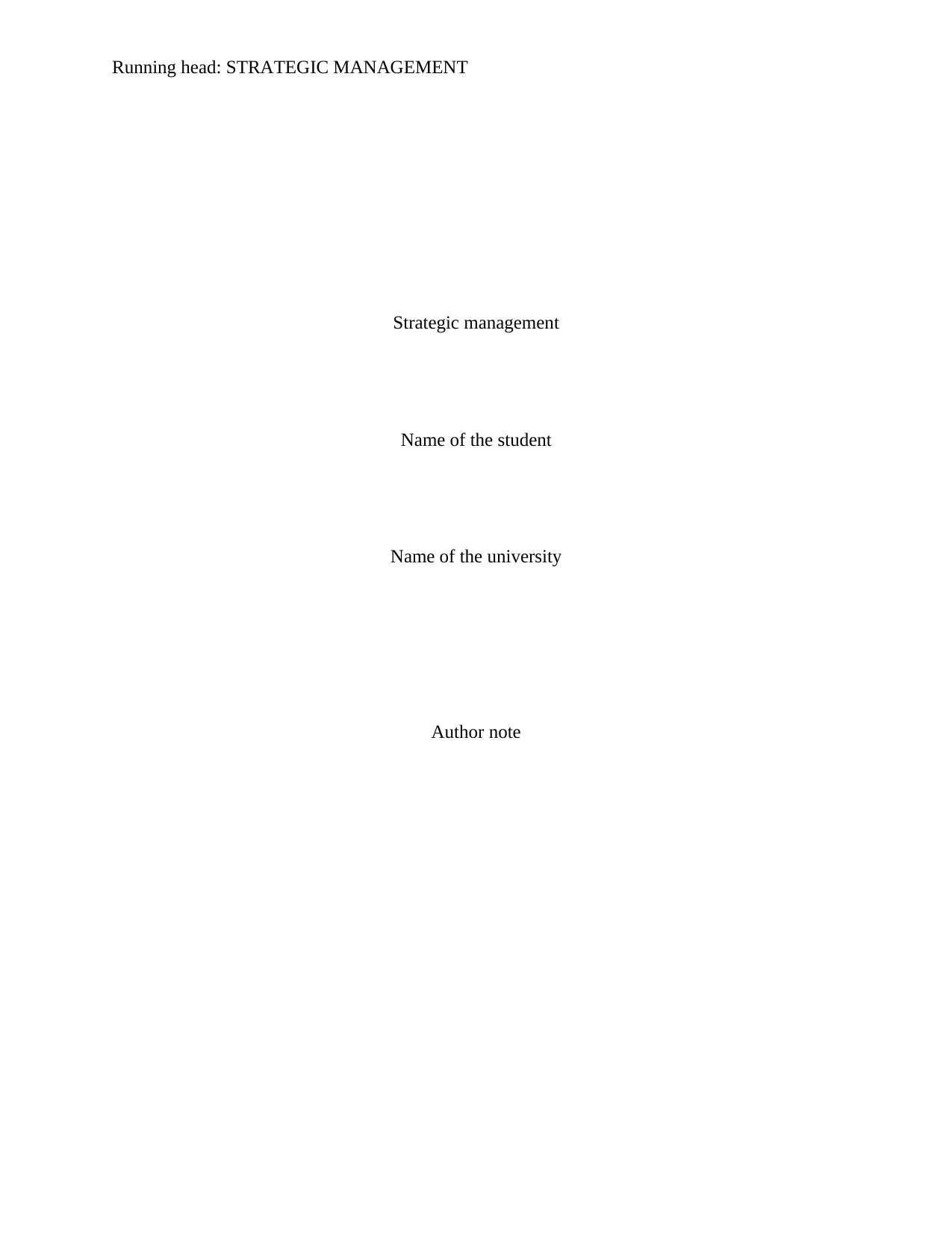
Running head: STRATEGIC MANAGEMENT
Strategic management
Name of the student
Name of the university
Author note
Strategic management
Name of the student
Name of the university
Author note
Secure Best Marks with AI Grader
Need help grading? Try our AI Grader for instant feedback on your assignments.
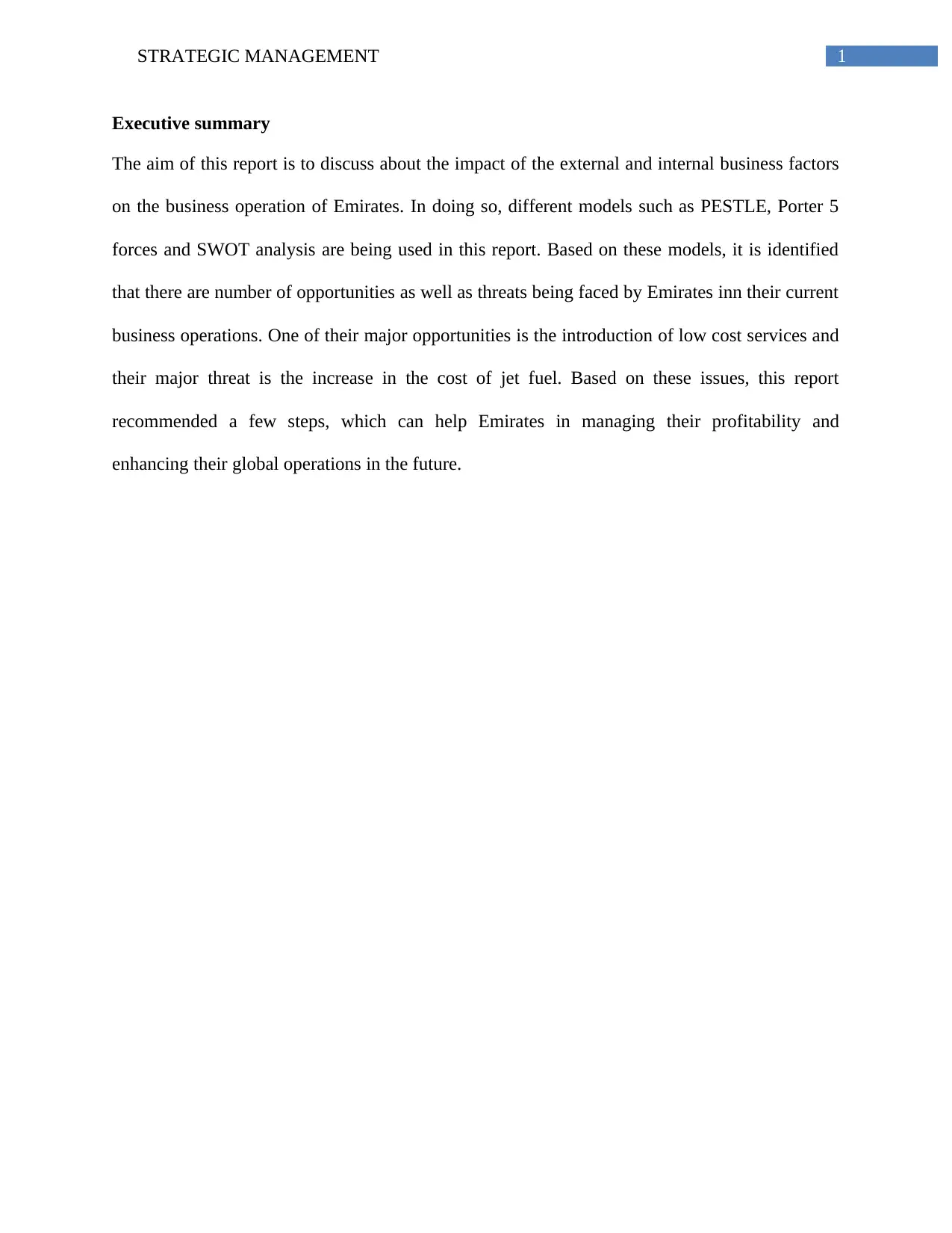
1STRATEGIC MANAGEMENT
Executive summary
The aim of this report is to discuss about the impact of the external and internal business factors
on the business operation of Emirates. In doing so, different models such as PESTLE, Porter 5
forces and SWOT analysis are being used in this report. Based on these models, it is identified
that there are number of opportunities as well as threats being faced by Emirates inn their current
business operations. One of their major opportunities is the introduction of low cost services and
their major threat is the increase in the cost of jet fuel. Based on these issues, this report
recommended a few steps, which can help Emirates in managing their profitability and
enhancing their global operations in the future.
Executive summary
The aim of this report is to discuss about the impact of the external and internal business factors
on the business operation of Emirates. In doing so, different models such as PESTLE, Porter 5
forces and SWOT analysis are being used in this report. Based on these models, it is identified
that there are number of opportunities as well as threats being faced by Emirates inn their current
business operations. One of their major opportunities is the introduction of low cost services and
their major threat is the increase in the cost of jet fuel. Based on these issues, this report
recommended a few steps, which can help Emirates in managing their profitability and
enhancing their global operations in the future.
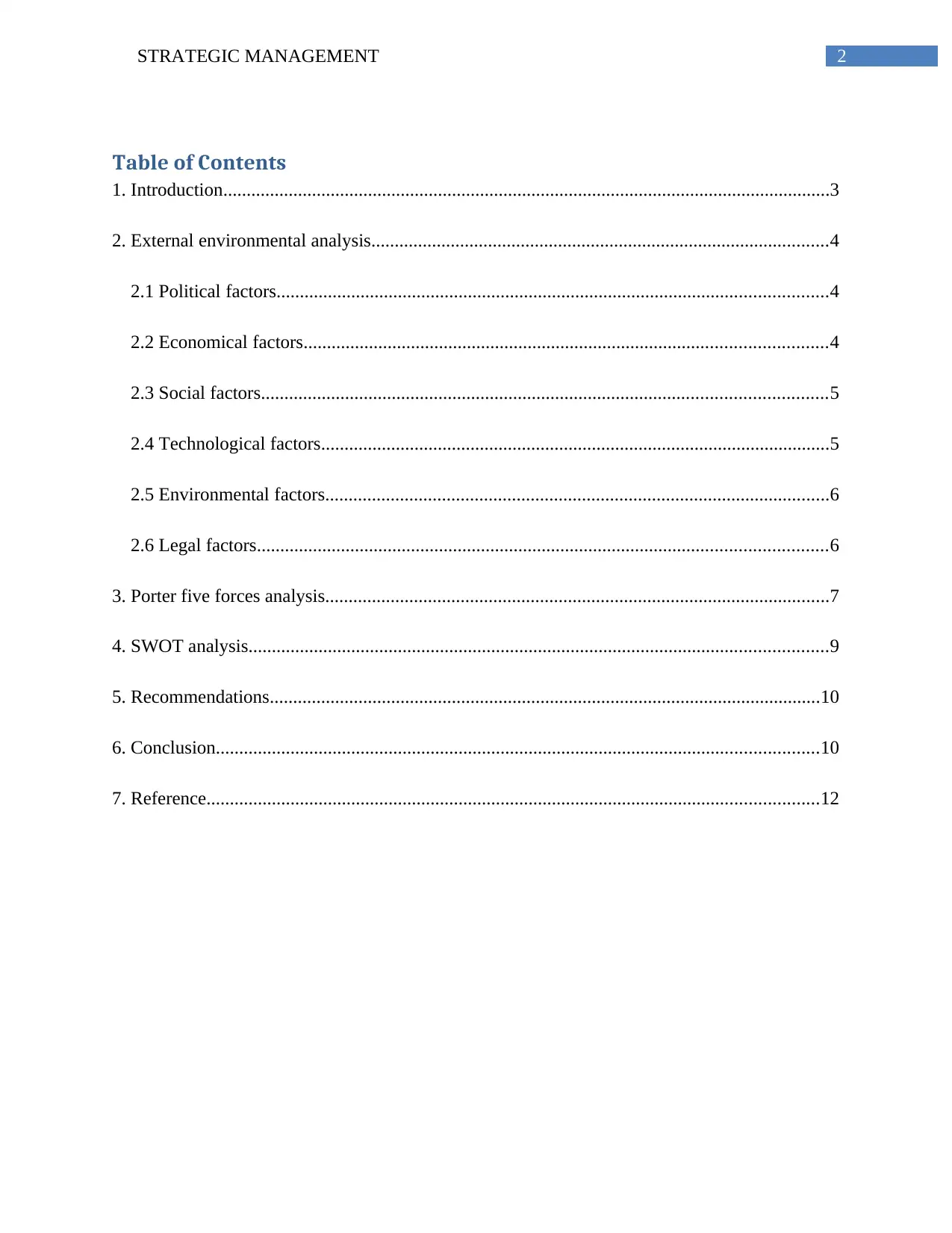
2STRATEGIC MANAGEMENT
Table of Contents
1. Introduction..................................................................................................................................3
2. External environmental analysis..................................................................................................4
2.1 Political factors......................................................................................................................4
2.2 Economical factors................................................................................................................4
2.3 Social factors.........................................................................................................................5
2.4 Technological factors.............................................................................................................5
2.5 Environmental factors............................................................................................................6
2.6 Legal factors..........................................................................................................................6
3. Porter five forces analysis............................................................................................................7
4. SWOT analysis............................................................................................................................9
5. Recommendations......................................................................................................................10
6. Conclusion.................................................................................................................................10
7. Reference...................................................................................................................................12
Table of Contents
1. Introduction..................................................................................................................................3
2. External environmental analysis..................................................................................................4
2.1 Political factors......................................................................................................................4
2.2 Economical factors................................................................................................................4
2.3 Social factors.........................................................................................................................5
2.4 Technological factors.............................................................................................................5
2.5 Environmental factors............................................................................................................6
2.6 Legal factors..........................................................................................................................6
3. Porter five forces analysis............................................................................................................7
4. SWOT analysis............................................................................................................................9
5. Recommendations......................................................................................................................10
6. Conclusion.................................................................................................................................10
7. Reference...................................................................................................................................12

3STRATEGIC MANAGEMENT
1. Introduction
Determination of the internal and external business environments is one of the major
factor considerations for the contemporary business organizations. This is due to the reason that
the current business state of affairs is getting changed rapidly and frequently with time. Hence, it
is getting more important for the contemporary business entities to cope up with these changes
and design their business strategies accordingly (Brueckner, Lee and Singer 2014). In addition,
with the help of the determination of the internal and external business factors, the potential
impacts of them can also be identified and the business organizations can be immune. In the
current business scenario, one of the intensely competitive business sectors in the airline sector.
This is due to the reason that commercial airline sector is witnessing huge growth across the
world and more brands are entering this sector. This is posing challenges for the existing players
as well as viability issue for the new entrants.
In the commercial airline market of United Arab Emirates, the leading airliner is the
Emirates airlines. They are based in Dubai International airport and currently are the fourth
largest carriers in the world. Emirates are also operating one of the highest numbers of aircrafts
in their fleet, which further helps them to provide the vast connectivity across the world (Squalli
2014). However, increase in the competition especially in the forms of low cost carriers is
affecting their profitability along with the change in the preference pattern of the customers.
Thus they are having the need for effective determination of the internal and external business
factors to identify the potential impacts.
1. Introduction
Determination of the internal and external business environments is one of the major
factor considerations for the contemporary business organizations. This is due to the reason that
the current business state of affairs is getting changed rapidly and frequently with time. Hence, it
is getting more important for the contemporary business entities to cope up with these changes
and design their business strategies accordingly (Brueckner, Lee and Singer 2014). In addition,
with the help of the determination of the internal and external business factors, the potential
impacts of them can also be identified and the business organizations can be immune. In the
current business scenario, one of the intensely competitive business sectors in the airline sector.
This is due to the reason that commercial airline sector is witnessing huge growth across the
world and more brands are entering this sector. This is posing challenges for the existing players
as well as viability issue for the new entrants.
In the commercial airline market of United Arab Emirates, the leading airliner is the
Emirates airlines. They are based in Dubai International airport and currently are the fourth
largest carriers in the world. Emirates are also operating one of the highest numbers of aircrafts
in their fleet, which further helps them to provide the vast connectivity across the world (Squalli
2014). However, increase in the competition especially in the forms of low cost carriers is
affecting their profitability along with the change in the preference pattern of the customers.
Thus they are having the need for effective determination of the internal and external business
factors to identify the potential impacts.
Secure Best Marks with AI Grader
Need help grading? Try our AI Grader for instant feedback on your assignments.

4STRATEGIC MANAGEMENT
This report will involve PESTLE, SWOT and Porter 5 forces analysis to determine the
environmental factors in the business of Emirates along with determining their impacts on the
marketing strategy and performance.
2. External environmental analysis
2.1 Political factors
Emirates airline is controlled by the government of United Arab Emirates and thus the
negative impacts of the political factors are less for them. However, this favorable situation is
only applicable for the national routes of Emirates rather than their international routes. This is
due the reason that due to the presence of government of United Arab Emirates in the ownership
of Emirates, the diplomatic issues with other countries such as Israel are more relevant (Milton-
Edwards 2018). Hence, diplomatic issues between United Arab Emirates with other countries
determine the business areas for Emirates. Moreover, the Middle Eastern region is one of most
conflicted zones in the world including terrorism, which is also having adverse impact on the
business of Emirates. The political instability in the region is major threat for Emirates
(Gasiorowski 2016). The more will be political instability, the more will be chance of Emirates
getting dissolved in the long term.
2.2 Economical factors
One of the major economical factors for Emirates is the emergence of global economic
recession. This is due to the reason that airliners are traditionally expensive mode of
transportation and Emirates are catering to the premium segments. Thus, emergence of the
economic recession will reduce the purchasing power of the customers and will affect the
revenue of Emirates. However, the positive economic outlook in the Asian region is a positive
This report will involve PESTLE, SWOT and Porter 5 forces analysis to determine the
environmental factors in the business of Emirates along with determining their impacts on the
marketing strategy and performance.
2. External environmental analysis
2.1 Political factors
Emirates airline is controlled by the government of United Arab Emirates and thus the
negative impacts of the political factors are less for them. However, this favorable situation is
only applicable for the national routes of Emirates rather than their international routes. This is
due the reason that due to the presence of government of United Arab Emirates in the ownership
of Emirates, the diplomatic issues with other countries such as Israel are more relevant (Milton-
Edwards 2018). Hence, diplomatic issues between United Arab Emirates with other countries
determine the business areas for Emirates. Moreover, the Middle Eastern region is one of most
conflicted zones in the world including terrorism, which is also having adverse impact on the
business of Emirates. The political instability in the region is major threat for Emirates
(Gasiorowski 2016). The more will be political instability, the more will be chance of Emirates
getting dissolved in the long term.
2.2 Economical factors
One of the major economical factors for Emirates is the emergence of global economic
recession. This is due to the reason that airliners are traditionally expensive mode of
transportation and Emirates are catering to the premium segments. Thus, emergence of the
economic recession will reduce the purchasing power of the customers and will affect the
revenue of Emirates. However, the positive economic outlook in the Asian region is a positive
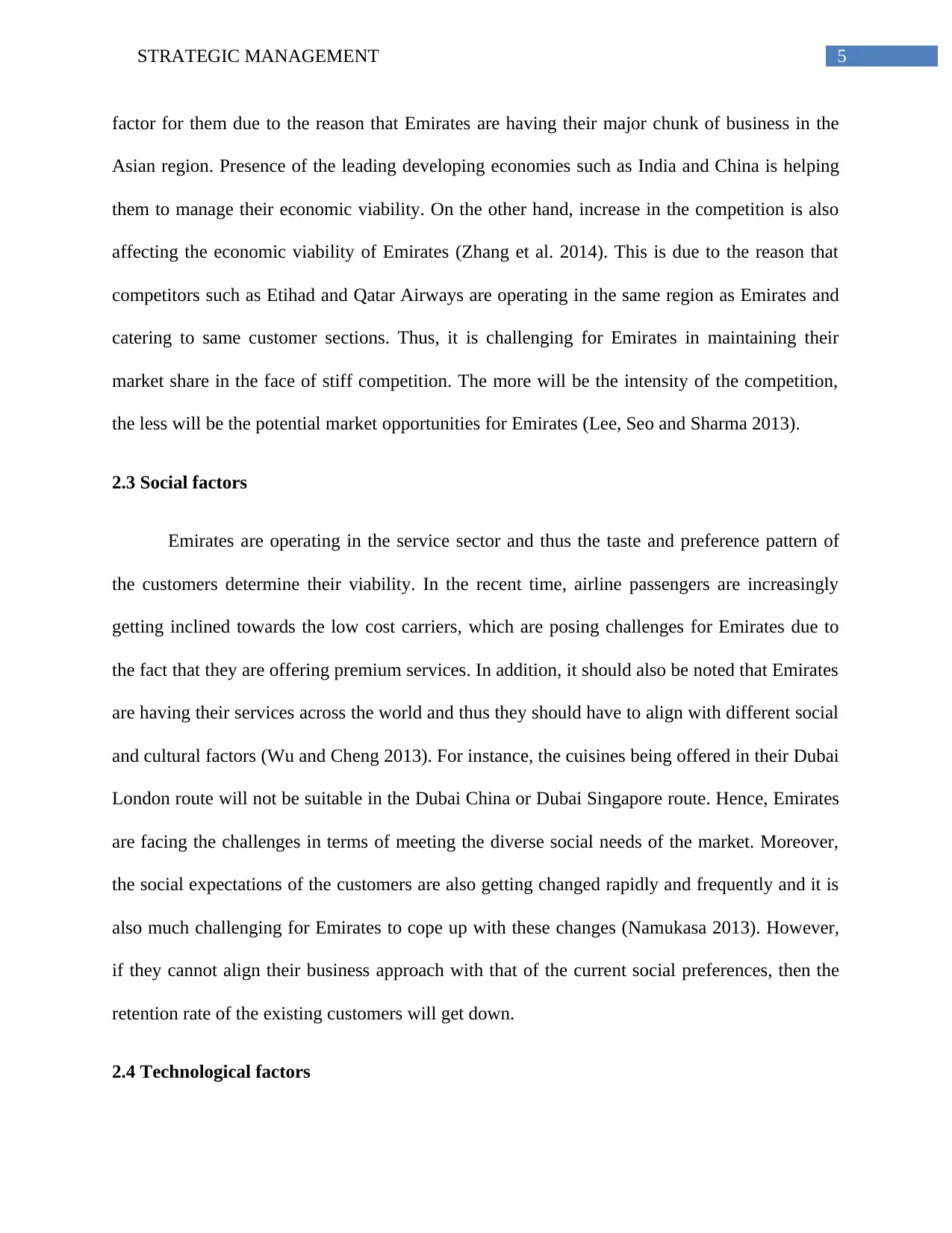
5STRATEGIC MANAGEMENT
factor for them due to the reason that Emirates are having their major chunk of business in the
Asian region. Presence of the leading developing economies such as India and China is helping
them to manage their economic viability. On the other hand, increase in the competition is also
affecting the economic viability of Emirates (Zhang et al. 2014). This is due to the reason that
competitors such as Etihad and Qatar Airways are operating in the same region as Emirates and
catering to same customer sections. Thus, it is challenging for Emirates in maintaining their
market share in the face of stiff competition. The more will be the intensity of the competition,
the less will be the potential market opportunities for Emirates (Lee, Seo and Sharma 2013).
2.3 Social factors
Emirates are operating in the service sector and thus the taste and preference pattern of
the customers determine their viability. In the recent time, airline passengers are increasingly
getting inclined towards the low cost carriers, which are posing challenges for Emirates due to
the fact that they are offering premium services. In addition, it should also be noted that Emirates
are having their services across the world and thus they should have to align with different social
and cultural factors (Wu and Cheng 2013). For instance, the cuisines being offered in their Dubai
London route will not be suitable in the Dubai China or Dubai Singapore route. Hence, Emirates
are facing the challenges in terms of meeting the diverse social needs of the market. Moreover,
the social expectations of the customers are also getting changed rapidly and frequently and it is
also much challenging for Emirates to cope up with these changes (Namukasa 2013). However,
if they cannot align their business approach with that of the current social preferences, then the
retention rate of the existing customers will get down.
2.4 Technological factors
factor for them due to the reason that Emirates are having their major chunk of business in the
Asian region. Presence of the leading developing economies such as India and China is helping
them to manage their economic viability. On the other hand, increase in the competition is also
affecting the economic viability of Emirates (Zhang et al. 2014). This is due to the reason that
competitors such as Etihad and Qatar Airways are operating in the same region as Emirates and
catering to same customer sections. Thus, it is challenging for Emirates in maintaining their
market share in the face of stiff competition. The more will be the intensity of the competition,
the less will be the potential market opportunities for Emirates (Lee, Seo and Sharma 2013).
2.3 Social factors
Emirates are operating in the service sector and thus the taste and preference pattern of
the customers determine their viability. In the recent time, airline passengers are increasingly
getting inclined towards the low cost carriers, which are posing challenges for Emirates due to
the fact that they are offering premium services. In addition, it should also be noted that Emirates
are having their services across the world and thus they should have to align with different social
and cultural factors (Wu and Cheng 2013). For instance, the cuisines being offered in their Dubai
London route will not be suitable in the Dubai China or Dubai Singapore route. Hence, Emirates
are facing the challenges in terms of meeting the diverse social needs of the market. Moreover,
the social expectations of the customers are also getting changed rapidly and frequently and it is
also much challenging for Emirates to cope up with these changes (Namukasa 2013). However,
if they cannot align their business approach with that of the current social preferences, then the
retention rate of the existing customers will get down.
2.4 Technological factors
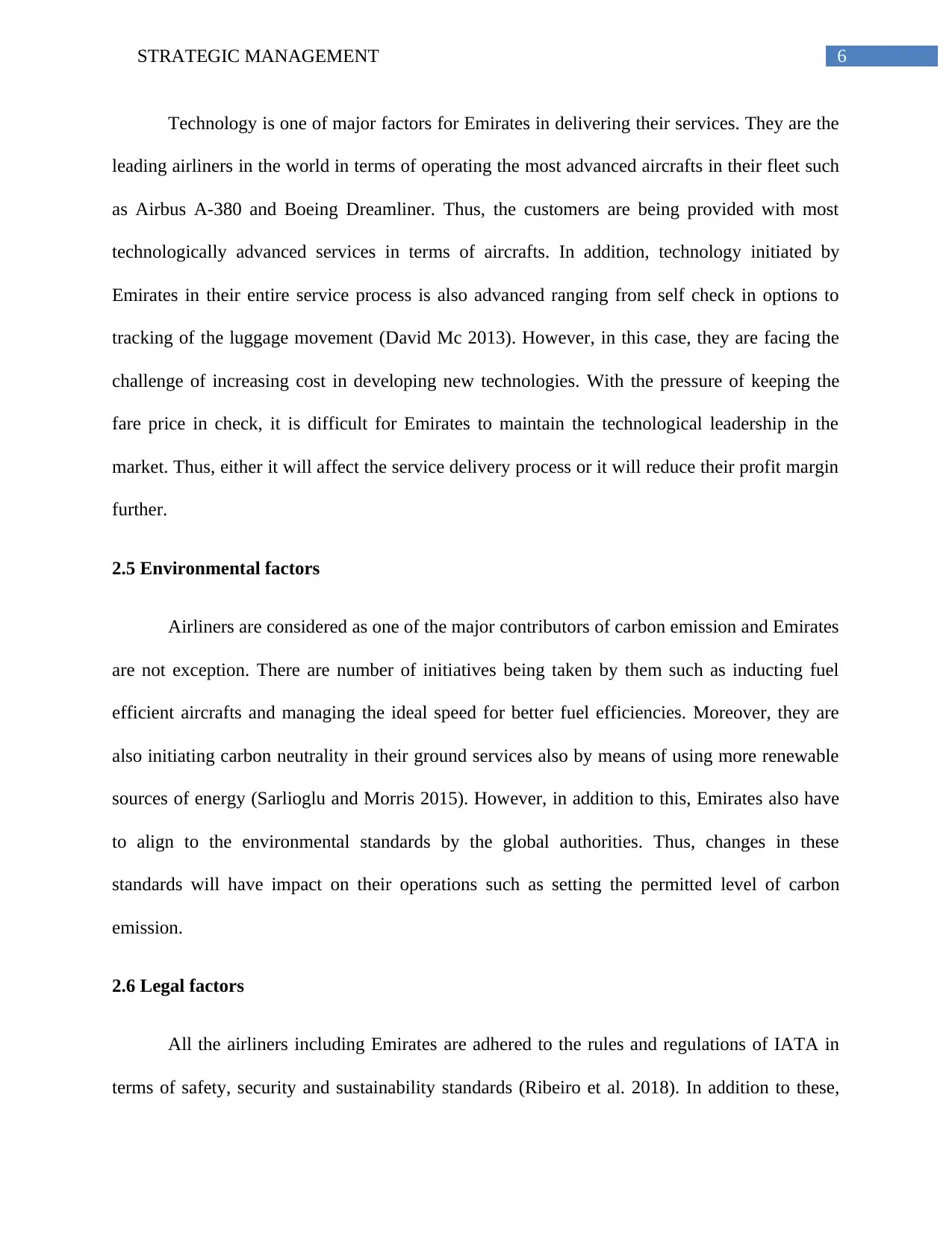
6STRATEGIC MANAGEMENT
Technology is one of major factors for Emirates in delivering their services. They are the
leading airliners in the world in terms of operating the most advanced aircrafts in their fleet such
as Airbus A-380 and Boeing Dreamliner. Thus, the customers are being provided with most
technologically advanced services in terms of aircrafts. In addition, technology initiated by
Emirates in their entire service process is also advanced ranging from self check in options to
tracking of the luggage movement (David Mc 2013). However, in this case, they are facing the
challenge of increasing cost in developing new technologies. With the pressure of keeping the
fare price in check, it is difficult for Emirates to maintain the technological leadership in the
market. Thus, either it will affect the service delivery process or it will reduce their profit margin
further.
2.5 Environmental factors
Airliners are considered as one of the major contributors of carbon emission and Emirates
are not exception. There are number of initiatives being taken by them such as inducting fuel
efficient aircrafts and managing the ideal speed for better fuel efficiencies. Moreover, they are
also initiating carbon neutrality in their ground services also by means of using more renewable
sources of energy (Sarlioglu and Morris 2015). However, in addition to this, Emirates also have
to align to the environmental standards by the global authorities. Thus, changes in these
standards will have impact on their operations such as setting the permitted level of carbon
emission.
2.6 Legal factors
All the airliners including Emirates are adhered to the rules and regulations of IATA in
terms of safety, security and sustainability standards (Ribeiro et al. 2018). In addition to these,
Technology is one of major factors for Emirates in delivering their services. They are the
leading airliners in the world in terms of operating the most advanced aircrafts in their fleet such
as Airbus A-380 and Boeing Dreamliner. Thus, the customers are being provided with most
technologically advanced services in terms of aircrafts. In addition, technology initiated by
Emirates in their entire service process is also advanced ranging from self check in options to
tracking of the luggage movement (David Mc 2013). However, in this case, they are facing the
challenge of increasing cost in developing new technologies. With the pressure of keeping the
fare price in check, it is difficult for Emirates to maintain the technological leadership in the
market. Thus, either it will affect the service delivery process or it will reduce their profit margin
further.
2.5 Environmental factors
Airliners are considered as one of the major contributors of carbon emission and Emirates
are not exception. There are number of initiatives being taken by them such as inducting fuel
efficient aircrafts and managing the ideal speed for better fuel efficiencies. Moreover, they are
also initiating carbon neutrality in their ground services also by means of using more renewable
sources of energy (Sarlioglu and Morris 2015). However, in addition to this, Emirates also have
to align to the environmental standards by the global authorities. Thus, changes in these
standards will have impact on their operations such as setting the permitted level of carbon
emission.
2.6 Legal factors
All the airliners including Emirates are adhered to the rules and regulations of IATA in
terms of safety, security and sustainability standards (Ribeiro et al. 2018). In addition to these,
Paraphrase This Document
Need a fresh take? Get an instant paraphrase of this document with our AI Paraphraser
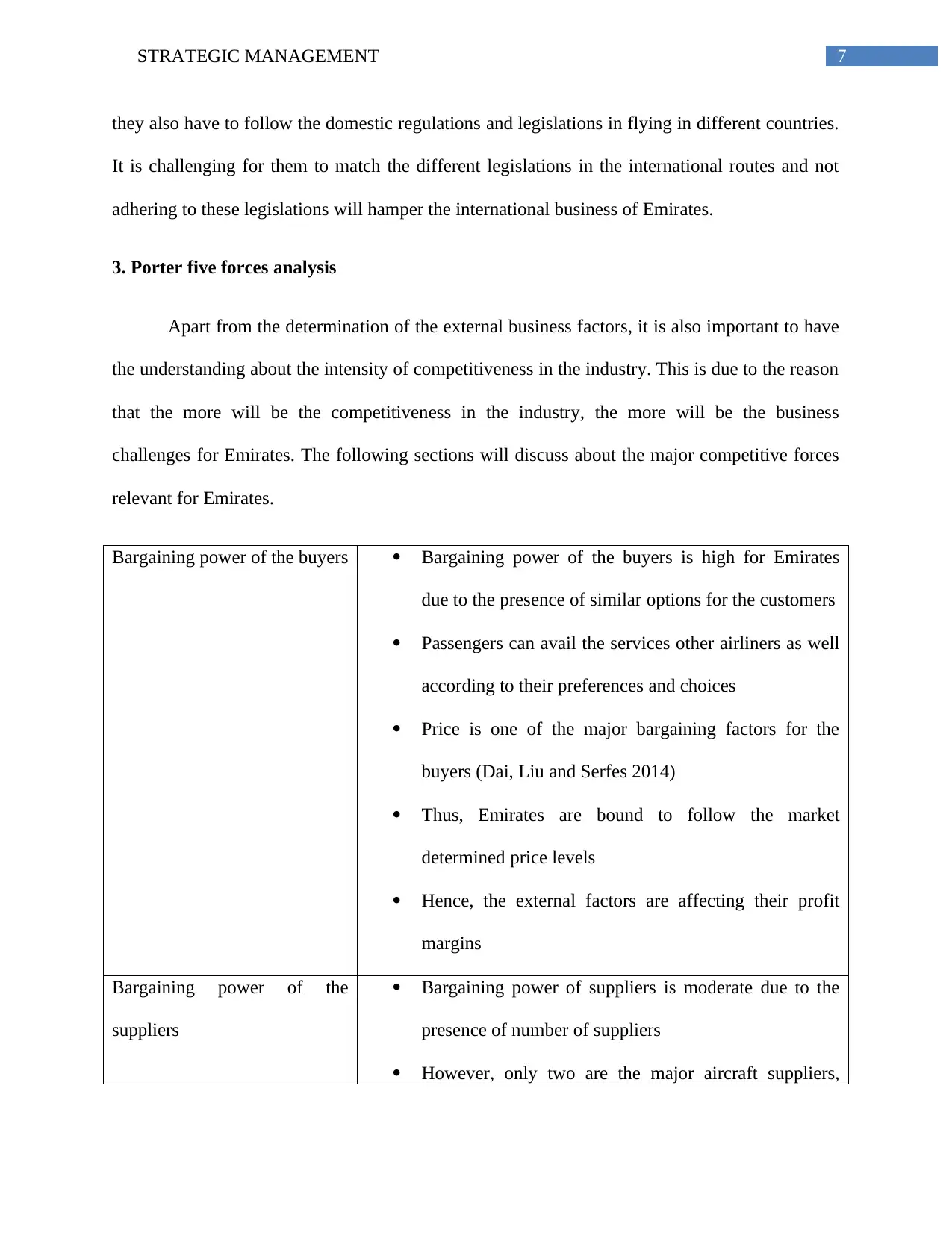
7STRATEGIC MANAGEMENT
they also have to follow the domestic regulations and legislations in flying in different countries.
It is challenging for them to match the different legislations in the international routes and not
adhering to these legislations will hamper the international business of Emirates.
3. Porter five forces analysis
Apart from the determination of the external business factors, it is also important to have
the understanding about the intensity of competitiveness in the industry. This is due to the reason
that the more will be the competitiveness in the industry, the more will be the business
challenges for Emirates. The following sections will discuss about the major competitive forces
relevant for Emirates.
Bargaining power of the buyers Bargaining power of the buyers is high for Emirates
due to the presence of similar options for the customers
Passengers can avail the services other airliners as well
according to their preferences and choices
Price is one of the major bargaining factors for the
buyers (Dai, Liu and Serfes 2014)
Thus, Emirates are bound to follow the market
determined price levels
Hence, the external factors are affecting their profit
margins
Bargaining power of the
suppliers
Bargaining power of suppliers is moderate due to the
presence of number of suppliers
However, only two are the major aircraft suppliers,
they also have to follow the domestic regulations and legislations in flying in different countries.
It is challenging for them to match the different legislations in the international routes and not
adhering to these legislations will hamper the international business of Emirates.
3. Porter five forces analysis
Apart from the determination of the external business factors, it is also important to have
the understanding about the intensity of competitiveness in the industry. This is due to the reason
that the more will be the competitiveness in the industry, the more will be the business
challenges for Emirates. The following sections will discuss about the major competitive forces
relevant for Emirates.
Bargaining power of the buyers Bargaining power of the buyers is high for Emirates
due to the presence of similar options for the customers
Passengers can avail the services other airliners as well
according to their preferences and choices
Price is one of the major bargaining factors for the
buyers (Dai, Liu and Serfes 2014)
Thus, Emirates are bound to follow the market
determined price levels
Hence, the external factors are affecting their profit
margins
Bargaining power of the
suppliers
Bargaining power of suppliers is moderate due to the
presence of number of suppliers
However, only two are the major aircraft suppliers,
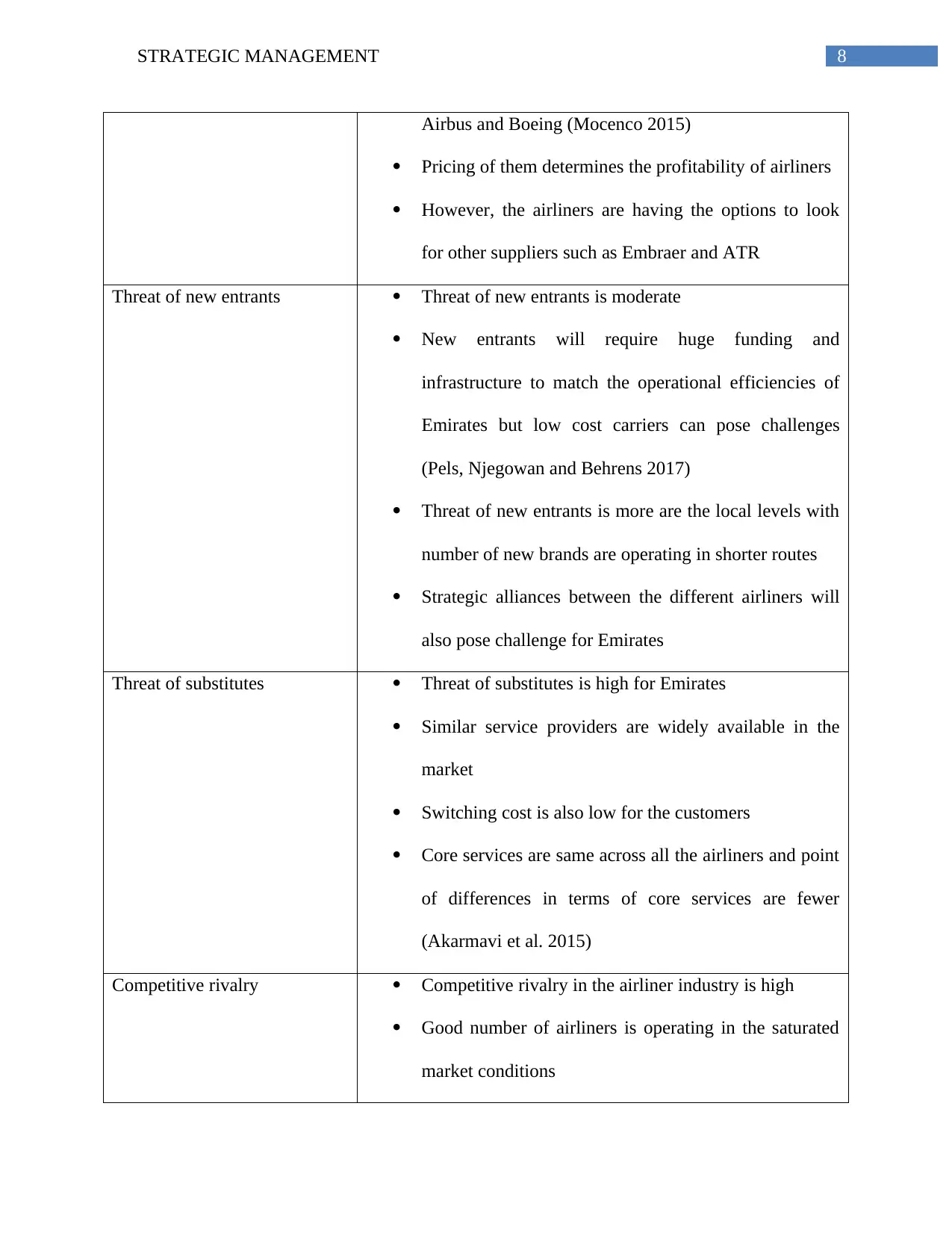
8STRATEGIC MANAGEMENT
Airbus and Boeing (Mocenco 2015)
Pricing of them determines the profitability of airliners
However, the airliners are having the options to look
for other suppliers such as Embraer and ATR
Threat of new entrants Threat of new entrants is moderate
New entrants will require huge funding and
infrastructure to match the operational efficiencies of
Emirates but low cost carriers can pose challenges
(Pels, Njegowan and Behrens 2017)
Threat of new entrants is more are the local levels with
number of new brands are operating in shorter routes
Strategic alliances between the different airliners will
also pose challenge for Emirates
Threat of substitutes Threat of substitutes is high for Emirates
Similar service providers are widely available in the
market
Switching cost is also low for the customers
Core services are same across all the airliners and point
of differences in terms of core services are fewer
(Akarmavi et al. 2015)
Competitive rivalry Competitive rivalry in the airliner industry is high
Good number of airliners is operating in the saturated
market conditions
Airbus and Boeing (Mocenco 2015)
Pricing of them determines the profitability of airliners
However, the airliners are having the options to look
for other suppliers such as Embraer and ATR
Threat of new entrants Threat of new entrants is moderate
New entrants will require huge funding and
infrastructure to match the operational efficiencies of
Emirates but low cost carriers can pose challenges
(Pels, Njegowan and Behrens 2017)
Threat of new entrants is more are the local levels with
number of new brands are operating in shorter routes
Strategic alliances between the different airliners will
also pose challenge for Emirates
Threat of substitutes Threat of substitutes is high for Emirates
Similar service providers are widely available in the
market
Switching cost is also low for the customers
Core services are same across all the airliners and point
of differences in terms of core services are fewer
(Akarmavi et al. 2015)
Competitive rivalry Competitive rivalry in the airliner industry is high
Good number of airliners is operating in the saturated
market conditions
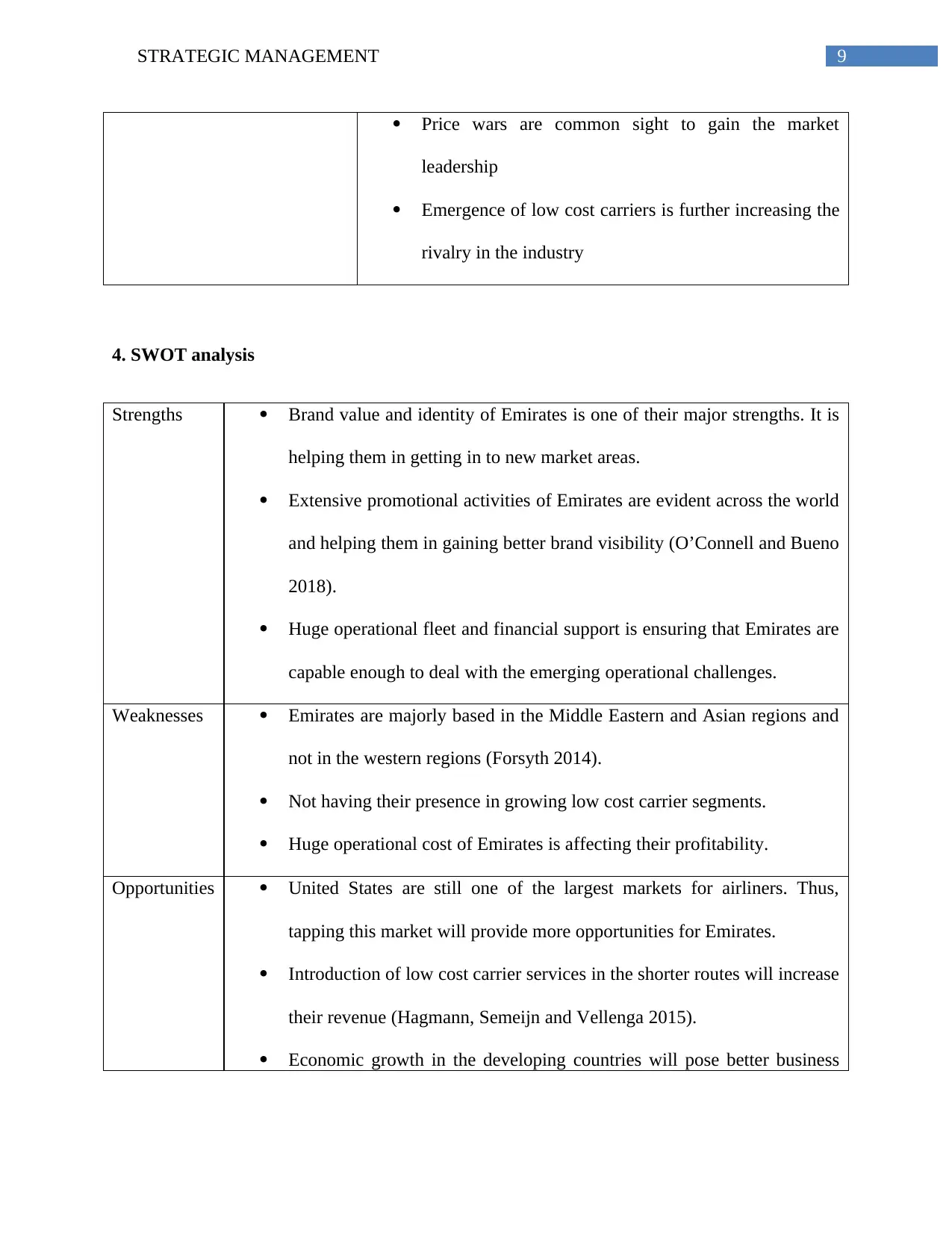
9STRATEGIC MANAGEMENT
Price wars are common sight to gain the market
leadership
Emergence of low cost carriers is further increasing the
rivalry in the industry
4. SWOT analysis
Strengths Brand value and identity of Emirates is one of their major strengths. It is
helping them in getting in to new market areas.
Extensive promotional activities of Emirates are evident across the world
and helping them in gaining better brand visibility (O’Connell and Bueno
2018).
Huge operational fleet and financial support is ensuring that Emirates are
capable enough to deal with the emerging operational challenges.
Weaknesses Emirates are majorly based in the Middle Eastern and Asian regions and
not in the western regions (Forsyth 2014).
Not having their presence in growing low cost carrier segments.
Huge operational cost of Emirates is affecting their profitability.
Opportunities United States are still one of the largest markets for airliners. Thus,
tapping this market will provide more opportunities for Emirates.
Introduction of low cost carrier services in the shorter routes will increase
their revenue (Hagmann, Semeijn and Vellenga 2015).
Economic growth in the developing countries will pose better business
Price wars are common sight to gain the market
leadership
Emergence of low cost carriers is further increasing the
rivalry in the industry
4. SWOT analysis
Strengths Brand value and identity of Emirates is one of their major strengths. It is
helping them in getting in to new market areas.
Extensive promotional activities of Emirates are evident across the world
and helping them in gaining better brand visibility (O’Connell and Bueno
2018).
Huge operational fleet and financial support is ensuring that Emirates are
capable enough to deal with the emerging operational challenges.
Weaknesses Emirates are majorly based in the Middle Eastern and Asian regions and
not in the western regions (Forsyth 2014).
Not having their presence in growing low cost carrier segments.
Huge operational cost of Emirates is affecting their profitability.
Opportunities United States are still one of the largest markets for airliners. Thus,
tapping this market will provide more opportunities for Emirates.
Introduction of low cost carrier services in the shorter routes will increase
their revenue (Hagmann, Semeijn and Vellenga 2015).
Economic growth in the developing countries will pose better business
Secure Best Marks with AI Grader
Need help grading? Try our AI Grader for instant feedback on your assignments.
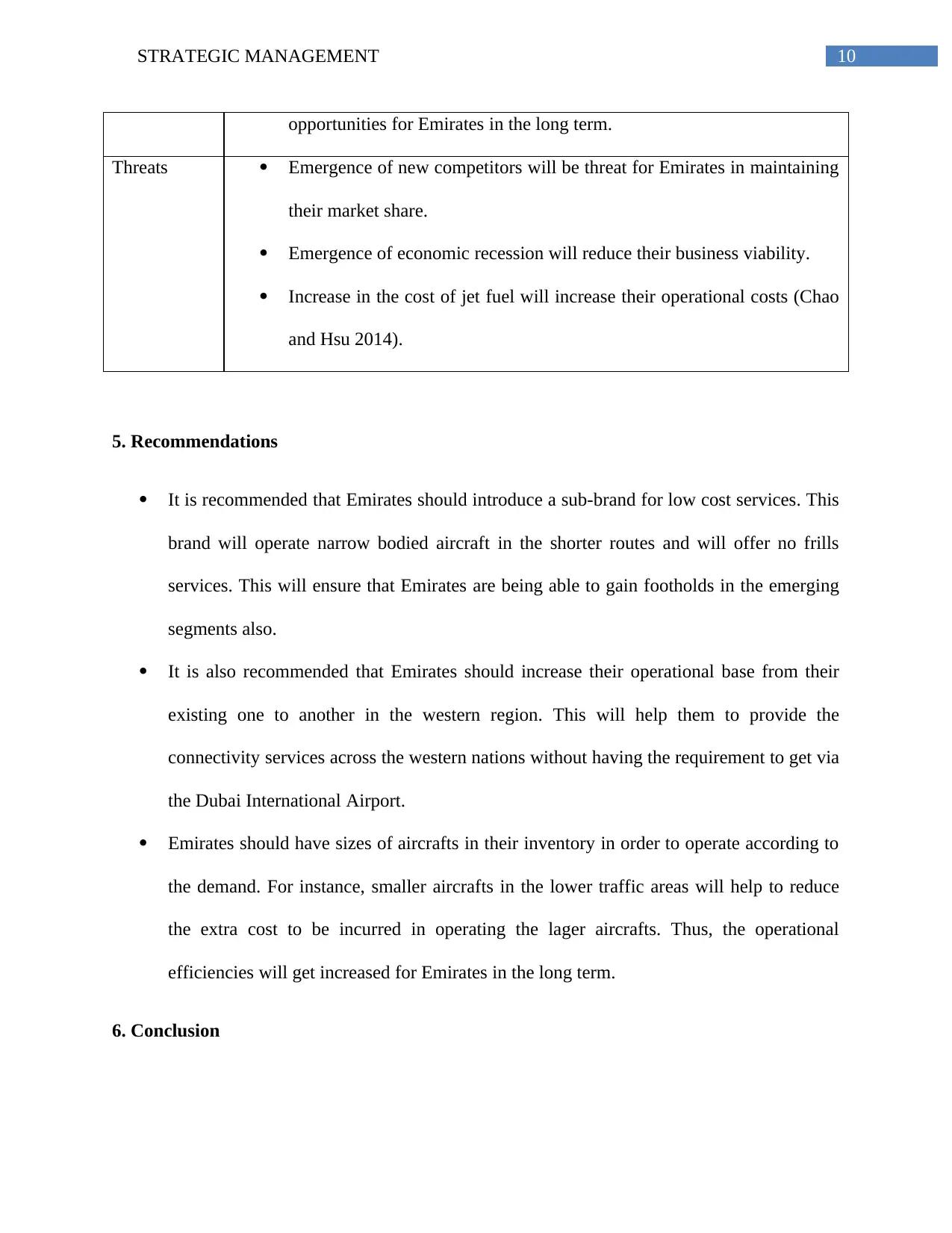
10STRATEGIC MANAGEMENT
opportunities for Emirates in the long term.
Threats Emergence of new competitors will be threat for Emirates in maintaining
their market share.
Emergence of economic recession will reduce their business viability.
Increase in the cost of jet fuel will increase their operational costs (Chao
and Hsu 2014).
5. Recommendations
It is recommended that Emirates should introduce a sub-brand for low cost services. This
brand will operate narrow bodied aircraft in the shorter routes and will offer no frills
services. This will ensure that Emirates are being able to gain footholds in the emerging
segments also.
It is also recommended that Emirates should increase their operational base from their
existing one to another in the western region. This will help them to provide the
connectivity services across the western nations without having the requirement to get via
the Dubai International Airport.
Emirates should have sizes of aircrafts in their inventory in order to operate according to
the demand. For instance, smaller aircrafts in the lower traffic areas will help to reduce
the extra cost to be incurred in operating the lager aircrafts. Thus, the operational
efficiencies will get increased for Emirates in the long term.
6. Conclusion
opportunities for Emirates in the long term.
Threats Emergence of new competitors will be threat for Emirates in maintaining
their market share.
Emergence of economic recession will reduce their business viability.
Increase in the cost of jet fuel will increase their operational costs (Chao
and Hsu 2014).
5. Recommendations
It is recommended that Emirates should introduce a sub-brand for low cost services. This
brand will operate narrow bodied aircraft in the shorter routes and will offer no frills
services. This will ensure that Emirates are being able to gain footholds in the emerging
segments also.
It is also recommended that Emirates should increase their operational base from their
existing one to another in the western region. This will help them to provide the
connectivity services across the western nations without having the requirement to get via
the Dubai International Airport.
Emirates should have sizes of aircrafts in their inventory in order to operate according to
the demand. For instance, smaller aircrafts in the lower traffic areas will help to reduce
the extra cost to be incurred in operating the lager aircrafts. Thus, the operational
efficiencies will get increased for Emirates in the long term.
6. Conclusion
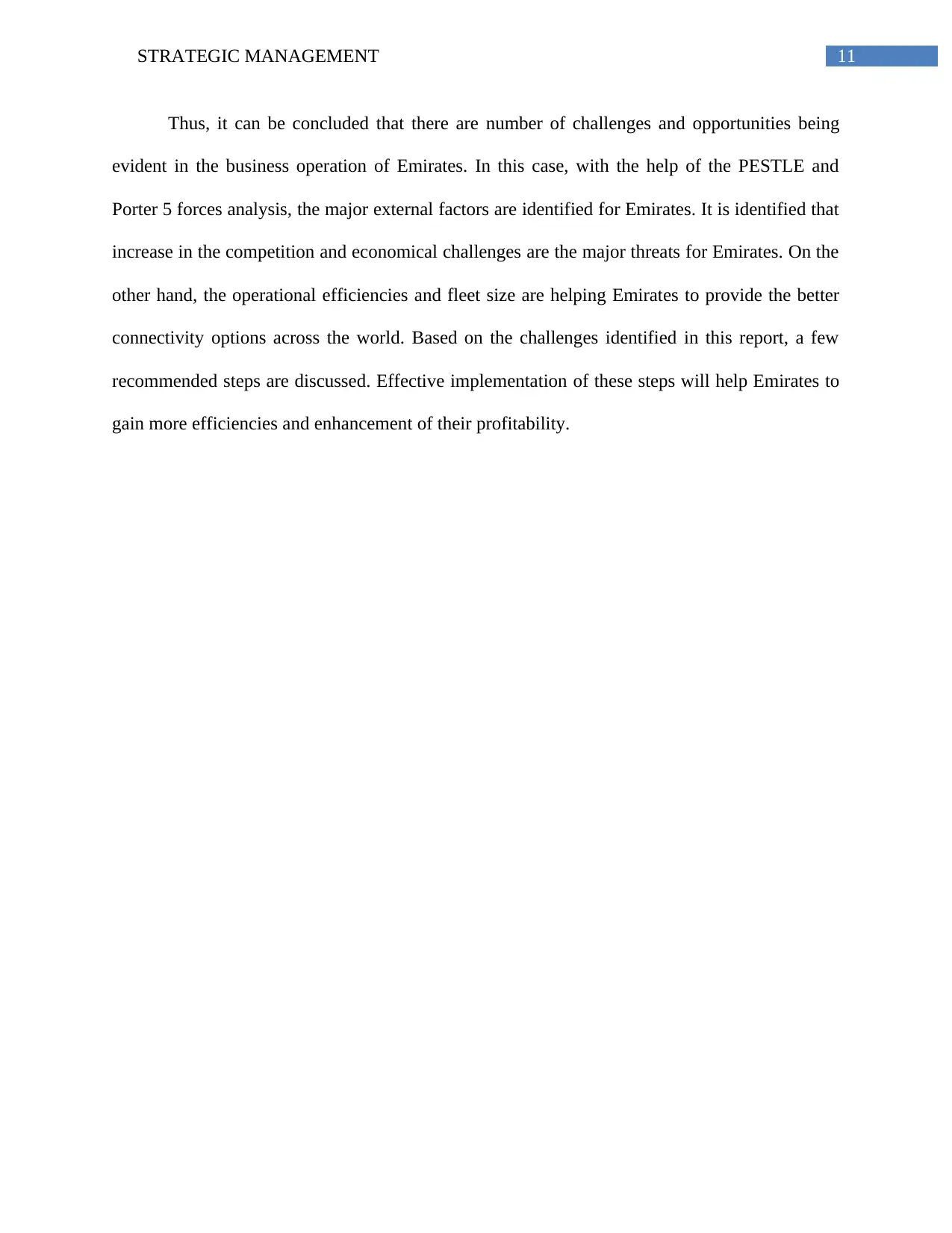
11STRATEGIC MANAGEMENT
Thus, it can be concluded that there are number of challenges and opportunities being
evident in the business operation of Emirates. In this case, with the help of the PESTLE and
Porter 5 forces analysis, the major external factors are identified for Emirates. It is identified that
increase in the competition and economical challenges are the major threats for Emirates. On the
other hand, the operational efficiencies and fleet size are helping Emirates to provide the better
connectivity options across the world. Based on the challenges identified in this report, a few
recommended steps are discussed. Effective implementation of these steps will help Emirates to
gain more efficiencies and enhancement of their profitability.
Thus, it can be concluded that there are number of challenges and opportunities being
evident in the business operation of Emirates. In this case, with the help of the PESTLE and
Porter 5 forces analysis, the major external factors are identified for Emirates. It is identified that
increase in the competition and economical challenges are the major threats for Emirates. On the
other hand, the operational efficiencies and fleet size are helping Emirates to provide the better
connectivity options across the world. Based on the challenges identified in this report, a few
recommended steps are discussed. Effective implementation of these steps will help Emirates to
gain more efficiencies and enhancement of their profitability.
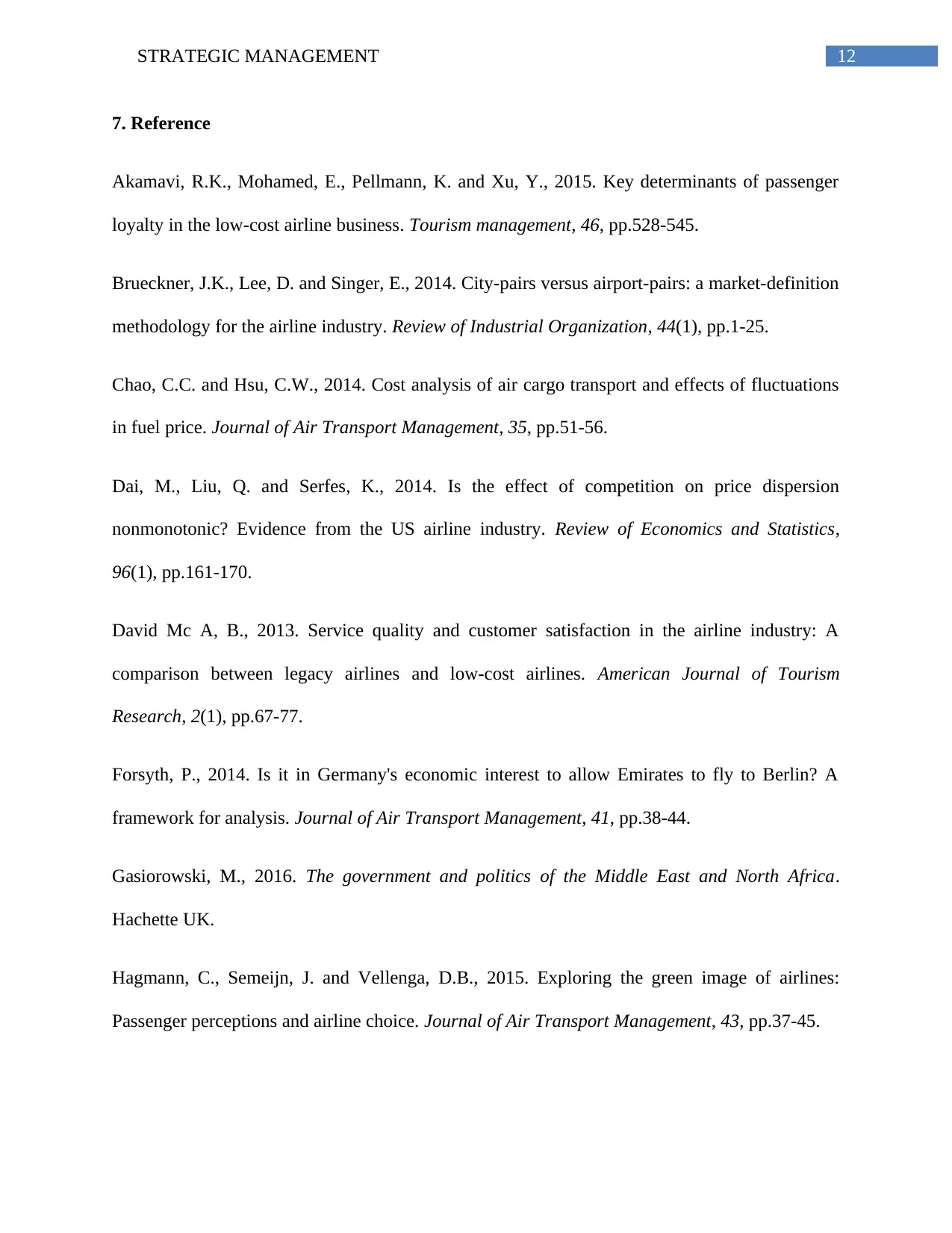
12STRATEGIC MANAGEMENT
7. Reference
Akamavi, R.K., Mohamed, E., Pellmann, K. and Xu, Y., 2015. Key determinants of passenger
loyalty in the low-cost airline business. Tourism management, 46, pp.528-545.
Brueckner, J.K., Lee, D. and Singer, E., 2014. City-pairs versus airport-pairs: a market-definition
methodology for the airline industry. Review of Industrial Organization, 44(1), pp.1-25.
Chao, C.C. and Hsu, C.W., 2014. Cost analysis of air cargo transport and effects of fluctuations
in fuel price. Journal of Air Transport Management, 35, pp.51-56.
Dai, M., Liu, Q. and Serfes, K., 2014. Is the effect of competition on price dispersion
nonmonotonic? Evidence from the US airline industry. Review of Economics and Statistics,
96(1), pp.161-170.
David Mc A, B., 2013. Service quality and customer satisfaction in the airline industry: A
comparison between legacy airlines and low-cost airlines. American Journal of Tourism
Research, 2(1), pp.67-77.
Forsyth, P., 2014. Is it in Germany's economic interest to allow Emirates to fly to Berlin? A
framework for analysis. Journal of Air Transport Management, 41, pp.38-44.
Gasiorowski, M., 2016. The government and politics of the Middle East and North Africa.
Hachette UK.
Hagmann, C., Semeijn, J. and Vellenga, D.B., 2015. Exploring the green image of airlines:
Passenger perceptions and airline choice. Journal of Air Transport Management, 43, pp.37-45.
7. Reference
Akamavi, R.K., Mohamed, E., Pellmann, K. and Xu, Y., 2015. Key determinants of passenger
loyalty in the low-cost airline business. Tourism management, 46, pp.528-545.
Brueckner, J.K., Lee, D. and Singer, E., 2014. City-pairs versus airport-pairs: a market-definition
methodology for the airline industry. Review of Industrial Organization, 44(1), pp.1-25.
Chao, C.C. and Hsu, C.W., 2014. Cost analysis of air cargo transport and effects of fluctuations
in fuel price. Journal of Air Transport Management, 35, pp.51-56.
Dai, M., Liu, Q. and Serfes, K., 2014. Is the effect of competition on price dispersion
nonmonotonic? Evidence from the US airline industry. Review of Economics and Statistics,
96(1), pp.161-170.
David Mc A, B., 2013. Service quality and customer satisfaction in the airline industry: A
comparison between legacy airlines and low-cost airlines. American Journal of Tourism
Research, 2(1), pp.67-77.
Forsyth, P., 2014. Is it in Germany's economic interest to allow Emirates to fly to Berlin? A
framework for analysis. Journal of Air Transport Management, 41, pp.38-44.
Gasiorowski, M., 2016. The government and politics of the Middle East and North Africa.
Hachette UK.
Hagmann, C., Semeijn, J. and Vellenga, D.B., 2015. Exploring the green image of airlines:
Passenger perceptions and airline choice. Journal of Air Transport Management, 43, pp.37-45.
Paraphrase This Document
Need a fresh take? Get an instant paraphrase of this document with our AI Paraphraser
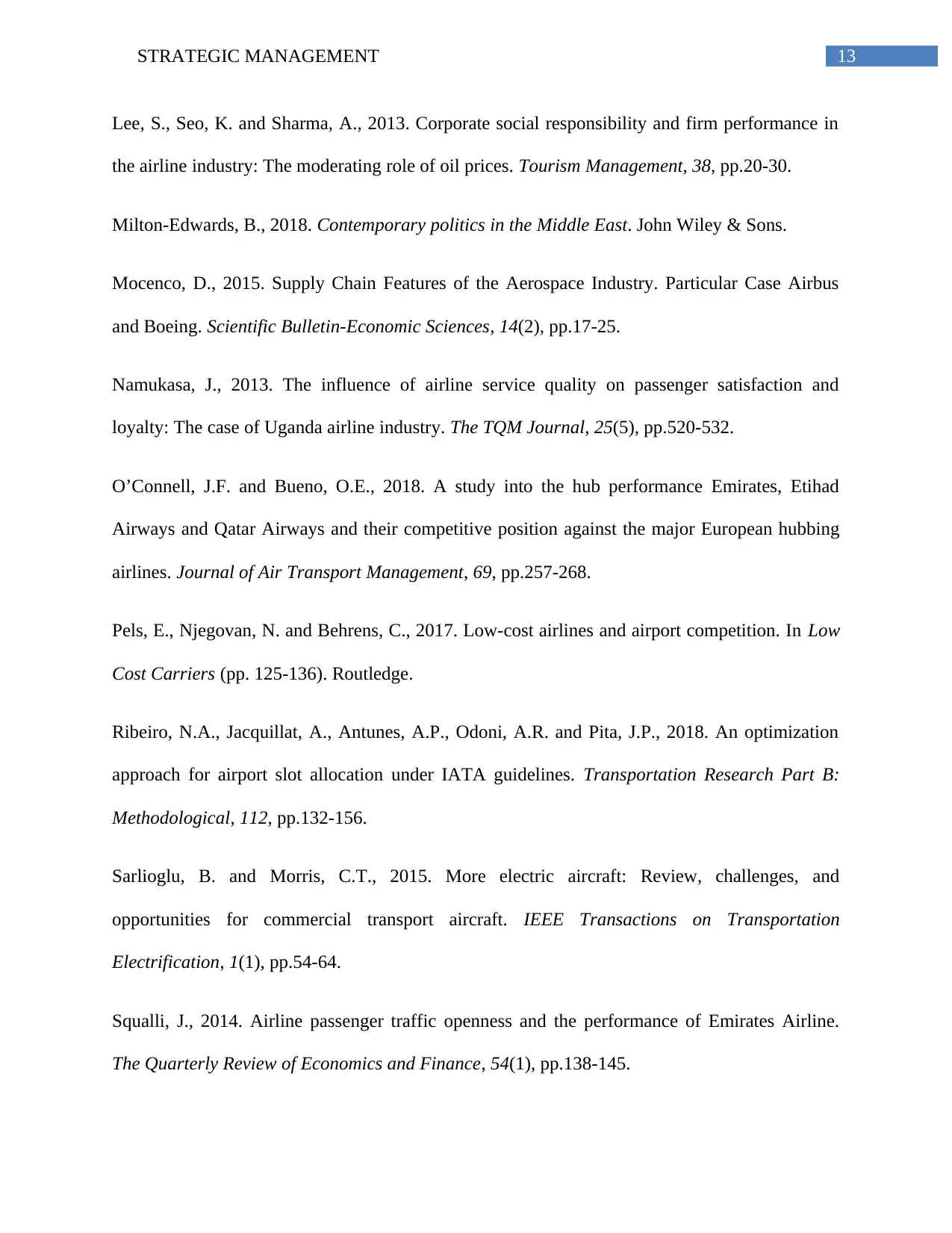
13STRATEGIC MANAGEMENT
Lee, S., Seo, K. and Sharma, A., 2013. Corporate social responsibility and firm performance in
the airline industry: The moderating role of oil prices. Tourism Management, 38, pp.20-30.
Milton-Edwards, B., 2018. Contemporary politics in the Middle East. John Wiley & Sons.
Mocenco, D., 2015. Supply Chain Features of the Aerospace Industry. Particular Case Airbus
and Boeing. Scientific Bulletin-Economic Sciences, 14(2), pp.17-25.
Namukasa, J., 2013. The influence of airline service quality on passenger satisfaction and
loyalty: The case of Uganda airline industry. The TQM Journal, 25(5), pp.520-532.
O’Connell, J.F. and Bueno, O.E., 2018. A study into the hub performance Emirates, Etihad
Airways and Qatar Airways and their competitive position against the major European hubbing
airlines. Journal of Air Transport Management, 69, pp.257-268.
Pels, E., Njegovan, N. and Behrens, C., 2017. Low-cost airlines and airport competition. In Low
Cost Carriers (pp. 125-136). Routledge.
Ribeiro, N.A., Jacquillat, A., Antunes, A.P., Odoni, A.R. and Pita, J.P., 2018. An optimization
approach for airport slot allocation under IATA guidelines. Transportation Research Part B:
Methodological, 112, pp.132-156.
Sarlioglu, B. and Morris, C.T., 2015. More electric aircraft: Review, challenges, and
opportunities for commercial transport aircraft. IEEE Transactions on Transportation
Electrification, 1(1), pp.54-64.
Squalli, J., 2014. Airline passenger traffic openness and the performance of Emirates Airline.
The Quarterly Review of Economics and Finance, 54(1), pp.138-145.
Lee, S., Seo, K. and Sharma, A., 2013. Corporate social responsibility and firm performance in
the airline industry: The moderating role of oil prices. Tourism Management, 38, pp.20-30.
Milton-Edwards, B., 2018. Contemporary politics in the Middle East. John Wiley & Sons.
Mocenco, D., 2015. Supply Chain Features of the Aerospace Industry. Particular Case Airbus
and Boeing. Scientific Bulletin-Economic Sciences, 14(2), pp.17-25.
Namukasa, J., 2013. The influence of airline service quality on passenger satisfaction and
loyalty: The case of Uganda airline industry. The TQM Journal, 25(5), pp.520-532.
O’Connell, J.F. and Bueno, O.E., 2018. A study into the hub performance Emirates, Etihad
Airways and Qatar Airways and their competitive position against the major European hubbing
airlines. Journal of Air Transport Management, 69, pp.257-268.
Pels, E., Njegovan, N. and Behrens, C., 2017. Low-cost airlines and airport competition. In Low
Cost Carriers (pp. 125-136). Routledge.
Ribeiro, N.A., Jacquillat, A., Antunes, A.P., Odoni, A.R. and Pita, J.P., 2018. An optimization
approach for airport slot allocation under IATA guidelines. Transportation Research Part B:
Methodological, 112, pp.132-156.
Sarlioglu, B. and Morris, C.T., 2015. More electric aircraft: Review, challenges, and
opportunities for commercial transport aircraft. IEEE Transactions on Transportation
Electrification, 1(1), pp.54-64.
Squalli, J., 2014. Airline passenger traffic openness and the performance of Emirates Airline.
The Quarterly Review of Economics and Finance, 54(1), pp.138-145.
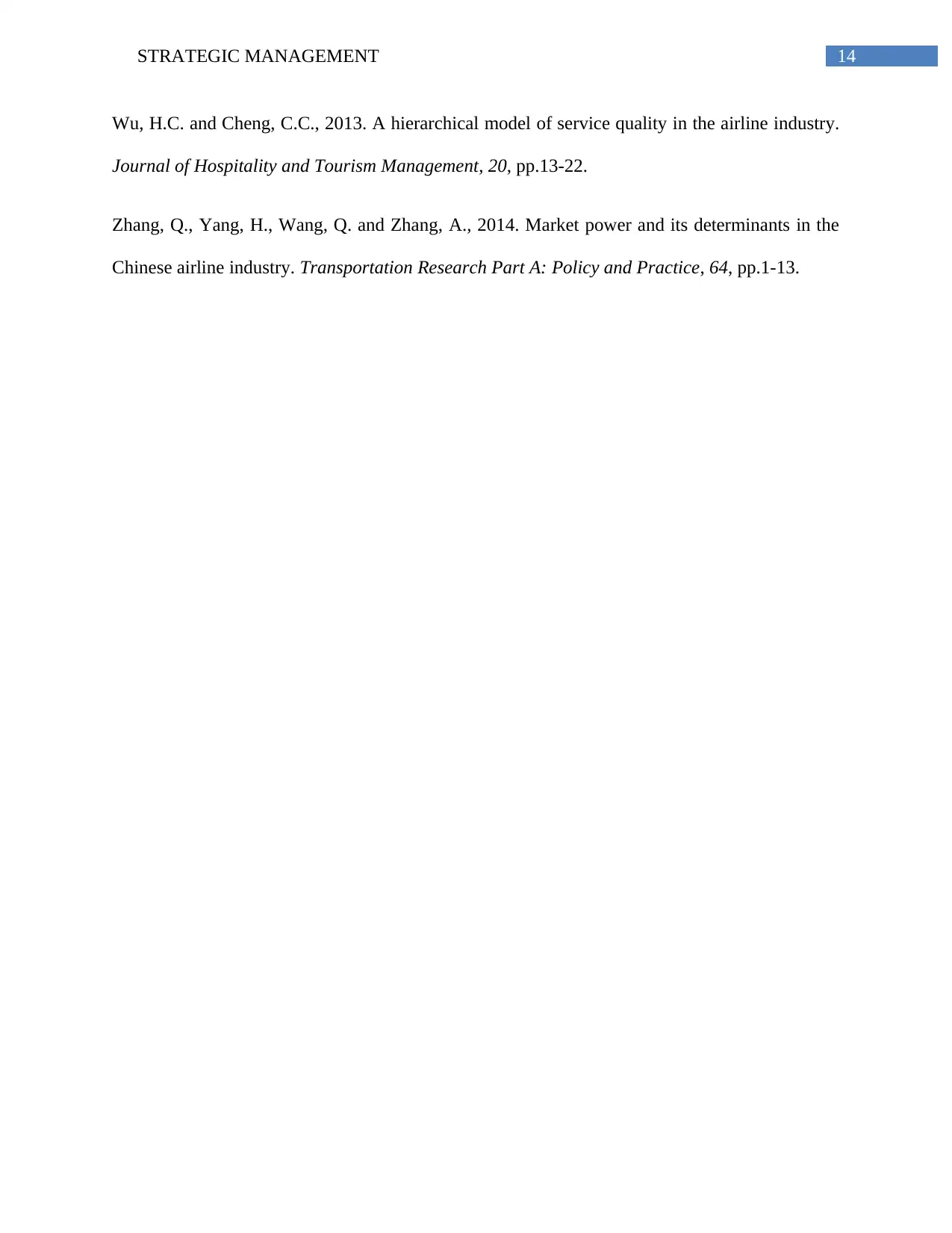
14STRATEGIC MANAGEMENT
Wu, H.C. and Cheng, C.C., 2013. A hierarchical model of service quality in the airline industry.
Journal of Hospitality and Tourism Management, 20, pp.13-22.
Zhang, Q., Yang, H., Wang, Q. and Zhang, A., 2014. Market power and its determinants in the
Chinese airline industry. Transportation Research Part A: Policy and Practice, 64, pp.1-13.
Wu, H.C. and Cheng, C.C., 2013. A hierarchical model of service quality in the airline industry.
Journal of Hospitality and Tourism Management, 20, pp.13-22.
Zhang, Q., Yang, H., Wang, Q. and Zhang, A., 2014. Market power and its determinants in the
Chinese airline industry. Transportation Research Part A: Policy and Practice, 64, pp.1-13.
1 out of 15
Related Documents
Your All-in-One AI-Powered Toolkit for Academic Success.
+13062052269
info@desklib.com
Available 24*7 on WhatsApp / Email
![[object Object]](/_next/static/media/star-bottom.7253800d.svg)
Unlock your academic potential
© 2024 | Zucol Services PVT LTD | All rights reserved.





